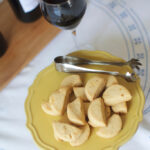 Even cheese lovers don’t always know what to make of the Norwegian cheese Gjetost, pronounced “Yay-toast.” It’s approximately the same texture as a young gouda, though perhaps stickier. It looks and tastes like a block of savory caramel. Blog posts about it (in English, anyway) use adjectives like “freakish” and discuss the possibility that candy companies have conspired to sell us confections disguised as cheese. The out-of-print Murray’s Cheese Handbook calls it “amazing, if somewhat revolting.”
Even cheese lovers don’t always know what to make of the Norwegian cheese Gjetost, pronounced “Yay-toast.” It’s approximately the same texture as a young gouda, though perhaps stickier. It looks and tastes like a block of savory caramel. Blog posts about it (in English, anyway) use adjectives like “freakish” and discuss the possibility that candy companies have conspired to sell us confections disguised as cheese. The out-of-print Murray’s Cheese Handbook calls it “amazing, if somewhat revolting.”
To understand Gjetost, it’s useful to have a basic understanding of the cheese-making process. To make cheese, you use enzymes and acidity to break milk into its parts: curds, which are the fat and protein solids, and whey, which comprises the leftover water, sugar, and some minerals.
When making every other type of cheese, you take the curds and send them on their way to cheesy glory by cooking, cutting, and maneuvering them into whichever cheese style you’re going for. When making Gjetost, you take the leftover whey and cook it down until it becomes a sweet and salty paste, thanks to the magic of the Maillard reaction. In this sense, it’s not exactly cheese, but doesn’t fit neatly into any other category either.
Gjetost, meaning “goat cheese” is part of the Brunost or “brown cheese” family. Part of what the Danish call Mysost or “whey cheese” family, this style of cheese has existed for just about forever. Thanks, though, to the workings of one Anne Hov, we have Gjetost in its modern form. 
Hov was born around 1846 in the tiny valley of Gudbrandsdalen. The agricultural census of 1865 reports her family’s farm as having four horses, 27 dairy cattle, seven sheep and five pigs. While goats were common in the region, Anne’s father Ola had sold the family’s goats years ago, as he found them noisy and chaotic.
One day in 1863, after visiting friends at a nearby farm, Anne asked her father for permission to make Gjetost with their leftover whey, which he granted. As she poured the whey into the pot, she added a splash of cream—quite a splurge at this point in history. The final product was delicious, though, and dubbed Feitost or “fat cheese.”
After marrying a nearby goat farmer, Anne started adding goat’s milk to her cheesy creation in addition to the cow cream and began to sell it in the nearby village. At the time, Gudbrandsdalen was in a major economic downturn.
After a few years of local success with the cheese, a trader named Ole Kongsli approached Anne about selling it in Oslo, the capital city. They sold it there as Gudbrandsdalsost or “cheese from Gudbrandsdalen” and it quickly grew in popularity. By 1908, they had built an industrial factory in Gudbrandsdalen for the sole purpose of producing Anne’s cheese.
Demand for this cheese saved this tiny region of Norway from financial ruin and Anne won the King’s Medal of Merit for her contributions to Norwegian cuisine and the economy. She was 87 years old. The internet still refers to her, the creator of a cheese empire, as a “milkmaid.”
Today, Gjetost remains popular in Norway, both as an ingredient to add richness and depth to game-based stews, but also as a topping on bread or waffles. Tine, Norway’s largest dairy producer, makes 12 variations, with different combinations of milk and cream, and varying levels of sweetness. In the US, the most popular version comes in red packaging and is often labeled “Ski Queen.”
In Norway, Gjetost generally pops up when eating breakfast or the last meal of the day—a post-dinner sort of return to breakfast food called kveldsmat. It pairs especially well with coffee or dark beers like stouts or porters. When spread thinly on bread with jam, it makes an excellent grilled cheese sandwich. Or, for a delicious, low-fuss snack, try slivers of Gjetost with apple slices.
Its genre-busting characteristics won’t appeal to everyone, but if you’re open-minded, it’s worth seeking out. Weird, wonderful Gjetost may just become your new favorite cheese.
 Christine Clark is a professional cheese and beverage nerd. Her work has appeared in VinePair, Fine Cooking, Travel + Leisure, and AFAR, and she has been featured in Bon Appetit, Complex, Epicurious, and the Huffington Post. She is a Certified Cheese Professional by the American Cheese Society. In her spare time, she plays with her dog and plans her next meal. Follow her latest eating adventures on Instagram @yourcheesefriend.
Christine Clark is a professional cheese and beverage nerd. Her work has appeared in VinePair, Fine Cooking, Travel + Leisure, and AFAR, and she has been featured in Bon Appetit, Complex, Epicurious, and the Huffington Post. She is a Certified Cheese Professional by the American Cheese Society. In her spare time, she plays with her dog and plans her next meal. Follow her latest eating adventures on Instagram @yourcheesefriend.


